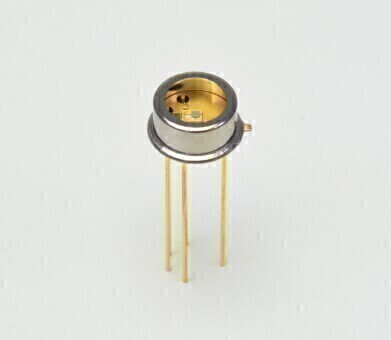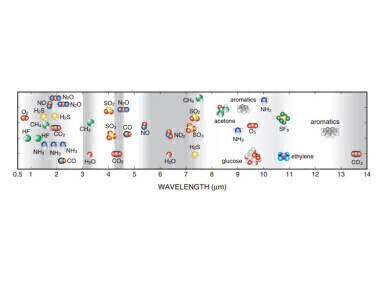-
 The InAsSb photovoltaic detector with built-in preamplifier P16702-011MN.
The InAsSb photovoltaic detector with built-in preamplifier P16702-011MN. -
 Application example of mid-infrared spectroscopy using P16702-011MN.
Application example of mid-infrared spectroscopy using P16702-011MN. -
 Application example of mid-infrared spectroscopy using P16702-011MN.
Application example of mid-infrared spectroscopy using P16702-011MN. -
 Wavelengths of light absorbed by molecules.
Wavelengths of light absorbed by molecules.
Mass Spectrometry & Spectroscopy
New Subminiature, Low-cost, High-sensitivity and Fast-response Detector with Built-in Preamplifier
Jan 26 2023
New InAsSb photovoltaic detector P16702-011MN
Hamamatsu Photonics have developed a new InAsSb photovoltaic detector (P16702-011MN) with built-in preamplifier offering high sensitivity to mid-infrared light, up to 11 micrometers (μm) in wavelength. This was achieved by combining the latest InAsSb (indium arsenide antimonide) mid-infrared detector with the company’s unique circuit design technology. Compared to Hamamatsu’s previous detector modules with same level of sensitivity, the P16702-011MN size and cost is drastically reduced, and it exhibits fast response time. This makes it an ideal choice for portable gas analysers able to immediately analyse exhaust gas components at measurement sites around factories.
Sales of the P16702-011MN will begin on Wednesday 1 February 2023 to domestic and overseas manufacturers of environmental measurement and analysis equipment. The P16702-011MN will also be on show at ‘SPIE Photonics West 2023’, an international conference on photonics and related technologies, held in San Francisco, California, USA from Tuesday 31 January to Thursday 2 February 2023.
Product overview
The P16702-011MN is a compound semiconductor photodetector with built-in preamplifier for electrical signal amplification.
Each molecule has its own vibration and absorbs infrared light at a specific wavelength determined by its energy. This property can be used to analyse and identify the type and quantity of chemical components contained in a sample. Therefore, mid-infrared light is widely utilised in the analysis of nitrogen oxides and sulphur oxides contained in exhaust gases from factories, etc.
To meet needs in applications such as gas analysis and monitoring of processing laser equipment, Hamamatsu develops and sells InAsSb mid-infrared detectors and detector module products with enhanced sensitivity, by integrating these with electronic circuits and components including preamplifiers. To keep up with the growing market demand of further downsizing equipment, the company have been working on a subminiature, low-cost mid-infrared detector device that also offers high-speed response.
In designing this new device, Hamamatsu adopted the latest back-illuminated type InAsSb mid-infrared detector with a sensitivity 1.5 times higher than the regular type. Encapsulated into a small cylindrical package with a diameter of approximately 9 mm, the device was drastically downsized to about 1/200th the volume of current module products, yet it still offers the same level of sensitivity capable of detecting mid-infrared light at wavelengths up to 11 μm. What’s more, the wiring in the package is optimised to increase the response speed up to 100 megahertz, which is twice as high as current module products, thus improving measurement accuracy. It also has a lower manufacturing cost since we reduced the number of required components.
The P16702-011MN will speed up the replacement of mercury-cadmium-telluride (MCT) infrared detectors which is currently the mainstream in high-precision mid-infrared spectroscopy but contains toxic substances restricted by the RoHS Directive [1]. Hamamatsu Photonics is one of the few companies in the world that manufacture both photodetectors and light sources. Using the P16702-011MN in conjunction with a quantum cascade laser or QCL [2], which the company also manufactures, allows making measurements at even higher speeds, resolution, and sensitivity.
Hamamatsu Photonics will continue designing and developing cooled-type detectors that remain unaffected by ambient temperature changes and in this way, increase the reliability of measurement results.
1. RoHS Directive is an EU directive that restricts the use of specified hazardous substances in electrical and electronic equipment. It was enacted to prohibit the sale of electrical and electronic equipment containing restricted substances in concentrations above a specified level on the European market.
2. Quantum cascade laser or QCL is a semiconductor light source utilising a special structure for the light-emitting layers. Unlike conventional lasers, it can generate high output power in the mid to far-infrared spectral range.
Digital Edition
ILM 49.5 July
July 2024
Chromatography Articles - Understanding PFAS: Analysis and Implications Mass Spectrometry & Spectroscopy Articles - MS detection of Alzheimer’s blood-based biomarkers LIMS - Essent...
View all digital editions
Events
Jul 28 2024 San Diego, CA USA
Jul 30 2024 Jakarta, Indonesia
Jul 31 2024 Chengdu, China
ACS National Meeting - Fall 2024
Aug 18 2024 Denver, CO, USA
Aug 25 2024 Copenhagen, Denmark


.jpg)
24_06.jpg)













